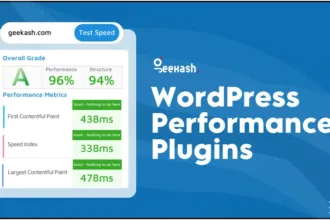Most bloggers are surprised to learn that writing only takes up 30% of their time. You might think blogging revolves around creating great content, but reality tells a different story.
Successful bloggers in 2025 need multiple blogging skills that reach way beyond writing. They must become skilled at SEO, marketing, visual creation, and email list building.
Modern blogging has evolved into a profession that demands versatile expertise. Your success in 2025 will depend on targeting micro-niches and broadening your income streams because display ads won’t sustain you anymore.
New bloggers and those looking to enhance their skills will find valuable insights in this piece. We’ll explore 10 crucial blogging skills you need to succeed in 2025’s competitive blogging world.
10 Blogging Skills Every Blogger Needs to Succeed in 2025
Success in blogging requires more than knowing how to write well. Recent data shows that 120 million workers need new training as AI changes how businesses work over the next three years. Now, let’s dive into the skills.
1. Content Writing
Quality content is the lifeblood of successful blogging. The latest data shows that 90% of businesses worldwide use content marketing strategies. This highlights why content creation skills matter so much today.
Writing engaging blog content needs more than just putting sentences together. You must understand what your readers want and what problems they face. Your focus should be on delivering value through well-researched posts that answer your audience’s specific questions.
Here are the key elements you need to create compelling content:
Good blog writing requires proper formatting to facilitate reading. Short paragraphs break content into smaller chunks, helping readers grasp information better. Relevant data and examples strengthen arguments and build trust with your audience.
Stories improve content. Sharing personal experiences and real-life examples makes your content more relatable. This helps you connect with readers and keeps them interested throughout the post.
Here’s a content creation process that works:
- Topic Research and Planning
- Look at what competitors write
- Find out what your audience asks
- Make detailed outlines
- Writing and Optimization
- Keep it clear and valuable
- Use relevant keywords
- Add visuals
- Editing and Refinement
- Check facts
- Make it easy to read
- Format properly
AI tools can help with research and writing sentences but can’t replace your unique voice. Your final content should show your personality and expertise rather than sound robotic or generic.
Reading extensively inside and outside your field will help you write better content. Practice writing regularly too. This will help you develop your own style while staying current with industry trends. Your blog posts will naturally stand out among others fighting for attention.
Your content should work well on different platforms since people often find content through social media and explore tabs. This helps your valuable content reach more readers on channels where your target audience spends time.
2. Search Engine Optimization (SEO)
SEO is a vital skill for bloggers who want to increase their content visibility. A First Page Sage study shows that websites in the first position on search results get a 39.8% click-through rate, which drops to 18.7% for the second position.
Knowing how to optimize keywords helps search engines better understand your content. Start your journey with detailed keyword research using tools like SE Ranking, Ahrefs, or Google Keyword Planner to discover what potential readers search for.
Despite that, avoid keyword stuffing, as it reduces readability and signals potential manipulation to search engines.
Your SEO-friendly blog posts should focus on these vital elements:
Search engines reward content that provides direct, easy-to-identify answers to frequently asked questions. Google’s E-E-A-T framework emphasizes experience, expertise, authority, and trustworthiness as vital components of quality content.
Internal linking becomes especially valuable when you want SEO success. You create topic clusters that show authority in your niche by connecting related content pieces. These links also help search engines understand the relationships between different content on your site.
Regular updates to older content through historical optimization will give it a fresh and relevant presence in search engine rankings. Analytics can also help you monitor your SEO performance to spot underperforming content and opportunities for improvement.
Note that dwell time—your reader’s time on your page indirectly signals content quality to search engines. Create detailed, well-laid-out content that keeps readers interested. Add multimedia elements like images and videos, but optimize them with descriptive alt text since search engines can’t directly interpret visual content.
Backlinks from respected sites greatly influence search rankings, working like an online peer review system. But focus on earning quality backlinks through valuable content instead of artificial link-building schemes.
Your blog posts will climb search rankings steadily with consistent use of these SEO principles. This approach attracts more organic traffic and builds authority in your chosen niche.
3. Marketing Skills
Your blog’s success in the competitive digital world depends on marketing excellence. Recent studies show that businesses using effective marketing strategies generate up to 67% more monthly leads than those without.
Successful blog marketing starts with knowing your target audience well. Detailed audience research helps you learn about their challenges, interests, and content preferences. This knowledge lets you create content that appeals to readers and establishes your blog as an authority.
A loyal blog following grows significantly through guest posting, though many overlook this powerful marketing channel. Your reach expands when you contribute valuable content to well-known industry publications. The key is to provide genuine insights rather than promotional content in your guest posts.
Email marketing has become crucial, as over 80% of marketers reported increased email engagement in 2020. A well-maintained email list keeps your audience consistently connected and informed about new content.
Paid promotion greatly benefits case studies and customer testimonials. You can reach interested audience segments through targeted advertising on LinkedIn for B2B or Facebook for B2C content.
Social media marketing requires more than sharing links. Content should be adapted to each platform’s format rather than posting direct blog links. For example, see how key insights can become engaging social graphics or short videos that work well with each platform’s algorithm.
Your marketing effectiveness becomes clear through data analysis. Important metrics to track include:
Your niche’s successful marketing strategies become apparent through competitor analysis. Their content formats, promotion channels, and audience engagement methods reveal stand-out opportunities.
Marketing efforts grow naturally through employee advocacy. Team members should share blog content through their professional networks, especially those with larger social media followings. Clear guidelines and engagement suggestions help maximize participation.
A sustainable framework for blog growth emerges when you consistently apply these marketing strategies and track performance metrics. Evidence-based adjustments to your approach should happen regularly.
4. CSS and HTML Skills
Learning HTML and CSS fundamentals helps you realize your blog’s full potential in appearance and functionality. Recent studies show that bloggers with simple coding knowledge spend 40% less time dealing with technical issues.
HTML forms the foundation of web content and uses tags to define page elements. These tags act as containers with opening and closing markers that tell browsers how to display content. To cite an instance, headers need simple tags:
HTML knowledge lets you:
Content formatting becomes easier once you learn essential HTML tags. Modern best practices suggest using semantic tags that search engines interpret better:
<strong> for bold text <em> for italics <span> for underlining
CSS enhances HTML by controlling your blog’s visual elements. CSS modifications include:
Good HTML implementation significantly affects SEO performance. Search engines prefer well-laid-out content with proper heading hierarchies and semantic markup. Clean code reduces page load times and improves your blog’s ranking potential.
These simple concepts are a great way to gain experience during troubleshooting. Without external support, you can quickly spot and fix common formatting issues that might affect your post’s appearance. This self-reliance saves time and resources while maintaining consistent blog quality.
HTML knowledge becomes especially useful when WordPress or similar platform users need to:
Lists need a specific HTML structure. The code uses <ul> for unordered (bullet) lists and <ol> for ordered (numbered) lists. Each list item requires <li> tags to ensure proper formatting and accessibility.
Understanding simple CSS helps maintain visual consistency throughout your blog. Small style adjustments ensure a professional and polished content appearance on all devices.
Note that clean and organized code matters. Heavy inline styling can slow down page loading speeds and hurt SEO performance. The best approach uses semantic HTML elements with separate style sheets to achieve optimal results.
5. WordPress Management
WordPress management is the foundation of successful blogging operations. WordPress powers over 40% of websites worldwide, and becoming skilled at its management capabilities will determine your long-term success.
Your blog’s performance depends heavily on choosing the right hosting provider. Good hosting guarantees fast speeds, high uptime, and reliable customer support. WordPress-specific features such as automated backups and updates make site maintenance easier.
Your WordPress site needs regular optimization to run smoothly. Look at your active plugins and remove unnecessary ones that slow down your site. Through selective plugin testing, you can measure server performance and find bottlenecks.
Site speed relies heavily on image optimization. Pick the right formats (JPG/PNG/GIF) and compression levels for each image. Modern formats like WebP offer smaller file sizes without quality loss.
Your database needs regular attention. Many optimization plugins help clean up database clutter and boost overall performance. High-traffic blogs should use load balancers that spread traffic across multiple web servers.
Content delivery networks (CDNs) substantially reduce server load. Moving images, JavaScript, CSS, and theme files to a CDN improves your site speed, reducing the load on your WordPress server.
Multi-author blogs need strong security measures. More admin area access means you need better protection. Tools like WP Activity Log track user actions and show you what authors do on your site.
Here’s how to set up user roles for better content management:
These maintenance tasks need regular attention:
- Updating WordPress core files
- Managing plugin updates
- Optimizing database performance
- Monitoring security logs
- Creating regular backups
Good WordPress management builds a stable foundation for your blog’s success. Check your site’s performance metrics often and tweak optimization strategies as needed. Caching solutions and proper security protocols help your growing blog run smoothly.
6. Social Media Skills
Social media platforms help expand your blog’s reach and connect with readers. Data shows that 3.96 billion active social media users spend over 30 minutes each day scrolling feeds and interacting with content.
Platform-specific features play a key role in creating content that resonates. Your strategic content planning can drive engagement across different networks. Marketers aim to increase engagement but struggle to create content that sparks desired interactions.
Your social media presence needs:
Social media management tools make content scheduling and analysis simple. These tools let you write captions, prepare visuals, and schedule posts ahead of time. Quality beats quantity—two to three excellent posts weekly work better than daily mediocre content.
Strong relationships with followers build your blog’s community. Quick responses to comments, answers to questions, and helpful information make a difference. Giveaways or contests show appreciation for your supporters’ engagement.
Your choice of platforms shapes success. Billions of social media users worldwide check competitor content, making unique content vital to attracting followers and boosting interactions with your brand.
User content drives natural engagement. Ask followers to share their experiences with your blog using specific hashtags. This builds trust and expands reach through real testimonials.
Social listening tools reveal audience sentiment and new trends. Monitoring conversations about your blog and industry gives valuable content creation insights. Analytics data shows demographics that help tailor content to reader priorities.
Success comes from creating value, not self-promotion. Educational posts, behind-the-scenes content, and thought-provoking questions start meaningful discussions. Platform features like Instagram Stories, LinkedIn Articles, and Facebook Groups boost visibility.
These strategies, combined with genuine engagement, will grow your social media presence and support blog growth. Performance metrics guide tactical adjustments based on audience response.
7. Analytics
Evidence-based decisions shape successful blogging strategies. Google Analytics and other tracking tools help you learn about your blog’s performance and audience behavior.
Understanding visitor experience across platforms helps cut reporting time by 50%. Metrics like pageviews, bounce rates, and conversion rates identify high-performing content and areas that need improvement. Google Analytics gives free customer insights that track the complete customer lifecycle.
Key metrics to monitor include:
Machine learning capabilities within analytics tools predict future customer actions and help optimize marketing ROI. Detailed tracking measures how viewers interact with your content and determines which types appeal best to your audience.
First-party data is a great way to make content distribution decisions. Metrics like average time on page and bounce rates help assess content effectiveness and make strategic improvements. Tracking conversion metrics like newsletter signups, form completions, and purchases shows how well your blog drives desired actions.
Analytics tools merge with other Google solutions to give a complete picture of marketing efforts. This connection helps optimize performance by linking insights directly to results. The detailed reporting interfaces let you analyze data quickly and work together using shareable reports.
Regular monitoring of blog analytics refines your content strategy with real data. Creating more content that matches your audience’s interests becomes easier when you know which posts generate the most engagement. Consumer insights also show when your main decision-makers are most active, which helps optimize publishing schedules.
Focus on metrics that line up with your blogging goals. While tracking many data points might seem tempting, prioritize measurements that directly affect your objectives. Consistent analysis and optimization based on analytics insights steadily improve your blog’s performance and reader engagement.
8. Pinterest Marketing Skills
Pinterest works more like a search engine than a social media platform to drive blog traffic. The visual discovery app handles over 2 billion monthly searches, which creates huge opportunities to expand your blog’s reach.
Your Pinterest success depends on visually appealing pins. Each blog post needs 3-5 different pin variations. A combination of regular pinning and strategic keyword use will help your content reach Pinterest’s 482 million monthly active users.
Rich Pins boost your blog’s visibility by syncing website information automatically. When you use Article Rich Pins, headlines, descriptions, and author names appear on the pins. Users get more context about your content before clicking, which leads to better engagement.
Your Pinterest strategy should include:
Pinterest analytics help you learn about pin performance and audience behavior. You should track impressions, saves, and click-through rates to make your strategy better. The patterns in your top-performing pins show what content strikes a chord with your audience.
Group boards can substantially expand your reach. These shared spaces let multiple creators post pins and help you connect with new audiences. The best results come from boards that match your specific niche.
The numbers tell an interesting story: Pinterest sends 33% more referral traffic to websites than Facebook. You can tap into this potential by adding “Pin It” buttons to your blog posts. It also helps to put Pinterest widgets on your website to showcase your boards.
Pinterest rewards patience and consistency. Quick results are rare, but steady pin creation and optimization lead to lasting traffic growth. A well-planned Pinterest marketing approach will help your blog build lasting visibility and an engaged reader base.
9. Monetization Skills
Bloggers can turn their platforms into money-making ventures by mastering multiple income streams. Recent studies show successful bloggers like Ryan Robinson generate upward of $30,000 per month through strategic monetization.
Affiliate marketing is the lifeblood of revenue generation. It lets you earn commissions by recommending products to your audience. Smart selection of affiliate partnerships helps bloggers create a steady passive income and stay authentic. Adam Enfroy started his blog as a side project and generated $1.5 million within two years.
Networks like Google AdSense, Mediavine, and Raptive give you reliable income through display advertising. Emily Brookes from Emily May Designs says display ads quickly became her most profitable channel. Note that websites with low traffic typically attract lower-quality ads.
Digital products tap into the full potential of scalable revenue. To name just one example, see these options:
Brand sponsorships become viable once you build substantial audience engagement. Avoid working just for product samples, as this often points to potential scams. Clear sponsorship packages help attract legitimate collaborations and maintain professional standards.
Email marketing is exceptionally profitable and serves as the most lucrative sales channel for many bloggers. A strong email list lets you communicate consistently and create opportunities for premium content subscriptions.
Your expertise opens doors to consulting services. As your blog builds authority, readers often ask for personalized guidance, creating opportunities for one-on-one coaching or group sessions.
Using multiple income sources is vital – successful bloggers typically run 3-5 income streams. This strategy gives you stability when individual revenue channels fluctuate. Smart implementation of these monetization methods while maintaining quality content helps transform your blog from a passion project into a sustainable business.
Profitable blogging needs a business mindset, clear goals, and consistent work to achieve them. Your primary focus should be on passive revenue streams, helping you scale income without increasing workload proportionally.
10. Branding Skills
Your blog needs a unique brand identity to stand out in today’s crowded digital world. Research shows that 77% of customers buy from brands that share their values, making brand development vital for any blog’s long-term success.
Brand strategy shapes how readers see your blog through multiple elements. A well-thought-out set of brand guidelines helps you create a consistent style, mission, and voice that strikes a chord with readers. Your readers will trust you more, and you’ll build natural relationships with your audience.
A deep understanding of your target market leads to an effective brand strategy. Companies using brand-focused approaches see 30% higher retention rates. Content that matches your audience’s values creates stronger connections and lasting loyalty.
Successful blog branding needs these core elements:
Authenticity is vital for reader participation. Industry experts suggest avoiding corporate-style content to encourage real connections. You can add personal touches through stories while keeping professional standards.
Your brand touchpoints need careful handling on every platform. Each interaction with your audience, from your website to your social media presence, shapes their view. Consistent messages and visuals create memorable experiences that make your blog unique.
Clear brand guidelines help maintain consistency. Your guidelines should define your blog’s:
Regular brand reviews lead to better results. Check how your audience responds to messages, visuals, and technology every few months. Data-driven improvements help your brand grow while keeping authentic reader connections.
How to Improve Blogging Skills
Becoming skilled at blogging takes dedication and a structured way to learn. Bloggers who put in 10,000 hours of practice with the right mindset typically become masters of their craft.
Your creative work needs specific time slots in spaces that boost productivity. A desk or local coffee shop can be your dedicated spot to maintain focus and create regular content. A content calendar helps you pick topics and stick to publishing schedules.
Reading lots of content in your niche makes you better faster. Great blogs teach you effective writing techniques and keep you up to date with industry trends. Fresh developments give you new angles to share with your readers.
Online courses are a great way to grow professionally. Skillshare and Udemy have specialized blogging courses that work for different skill levels. These learning paths show you where to improve your blogging toolkit.
The right tools boost your content quality by a lot. Grammarly helps you write without errors, while Hemingway Editor spots complex sentences and passive voice. These resources make your writing clear and striking.
The Kaizen principle—small, steady improvements to your blogging practice—leads to continuous growth. This method keeps you from feeling overwhelmed while you progress in all these essential skills.
Your peers’ and readers’ feedback helps you improve. Take constructive criticism and use it to shape your content strategy. Analytics also show which posts strike a chord with your audience.
A blog coach can guide you toward faster growth with tailored advice. One-on-one mentoring helps bloggers handle challenges better than learning alone.
Success in blogging comes from patient persistence, not quick wins. Dedicated practice and constant learning will steadily improve your skills, which leads to lasting growth and reader participation.
Final Thought
Successful blogging requires multiple skills and adaptability to industry changes. Your blog can thrive in 2025’s competitive digital world if you practice these ten capabilities consistently.
Each skill strengthens the others and creates a solid base to stimulate growth. Technical skills like WordPress management and HTML work alongside creative talents in content writing and visual design. Marketing knowledge combined with analytical thinking helps you connect with target audiences. You can measure success through evidence-based decisions.
Your journey to becoming a skilled blogger takes patience and steady work. Begin by spotting areas you should improve, then develop well-laid-out learning plans. Successful bloggers prioritize genuine reader value over quick wins.
Blogging combines both art and science – you need creative and strategic thinking. Of course, these ten skills take time to develop, but regular practice helps you become an authority in your chosen niche. Your dedication to learning and your ability to adapt to new trends will help your blog succeed.











